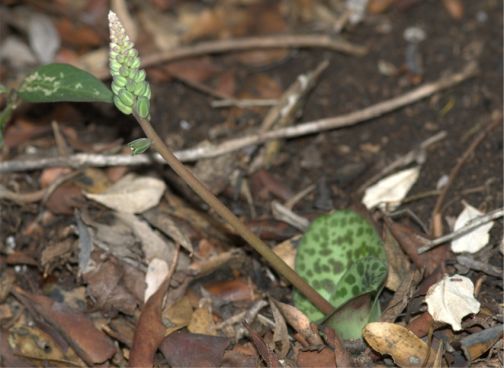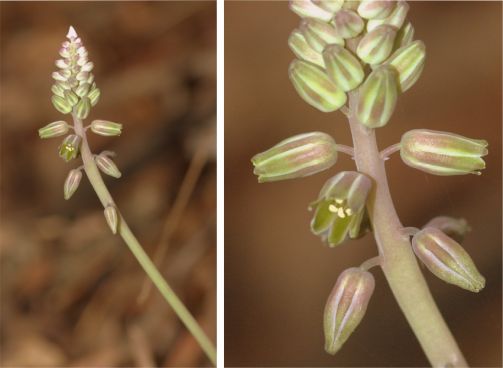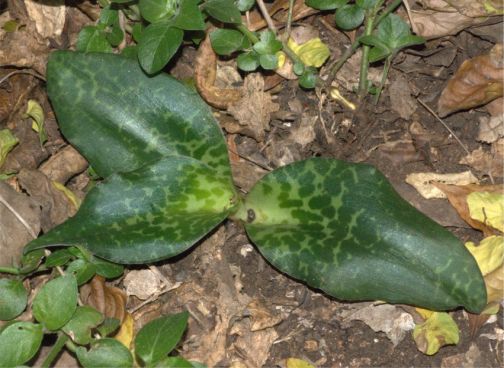Ledebouria humifusa
Ledebouria humifusa (Baker) J.C.Manning & Goldblatt
Family: Hyacinthaceae
Common names: broad-leaved African hyacinth
Introduction
The broad-leaved African hyacinth is a bulbous plant with broad usually spotted leaves, which prefers to grow in the shade of forests or wooded areas amongst leaf litter.

Fig. 1. Ledebouria humifusa plants growing on the florest floor, Muden, KwaZulu-Natal, note the partially exposed green bulb.
Description
Description
Small to medium-sized usually solitary bulbous plant, with white to pinkish or green bulbs that can reach up to 50 mm long and 50 mm wide. Like other members of the section Resnova it does not possess a tunic (dry sheath of old bulb scales covering the bulb), which is commonly seen in the section Ledebouria, instead the bulbs are naked with truncated bulb scales. The bulbs of this species are sometimes partially exposed above ground, in which case they are then usually green or pinkish. Stalkless leaves are produced in summer, usually 2 to 7, broadly lanceolate to oblanceolate, up to 250 mm long and 50 mm wide but forms with smaller leaves also exist. The leaves vary in colour from mid- to dark green usually with darker green spots or occasionally unspotted. The upper surface is usually glossy or slightly dull and completely hairless with a wavy margin. The underside of the leaf is smooth, hairless and usually green to pinkish green.

Fig. 2. A new inflorescence emerging in early spring.
Flowers are produced in spring and early summer (September to October). Each bulb usually produces a solitary (occasionally up to 3 per bulb), elongated inflorescence, which can be up to 350 mm long, initially erect, quite soon leaning then becoming floppy as the fruit develops. Numerous, loosely arranged, bell-shaped, greenish or brownish and off-white to pinkish striped, nodding small flowers (florets) are presented on a green flower stalk. Each floret is comprised of 6 elongated tepals (petals), and is attached by a short pedicel (stalk). Typical of the section Resnova the flowers are unscented and the tepals spread apically creating a bell-shaped flower. The flowers are soon followed by swollen green capsules which soon wither to reveal the dull dark brown wrinkled seeds.

Fig. 3. A close-up of the flowers showing green tepals with whitish to pinkish margins.
Conservation Status
Status
Ledebouria humifusa is assessed as Least Concern (LC) in the Red List of South African Plants. The species is widespread and not regarded to be under threat in its natural habitat.
Distribution and habitat
Distribution description
This species occurs in South Africa in the Eastern Cape, KwaZulu-Natal and Mpumalanga provinces, and in Eswatini. It is usually found under the canopy of forests or forest margins and dense woodland amongst rocks in the shade.

Fig. 4. Ledebouria humifusa plants in habtat on the florest floor, Muden, KwaZulu-Natal.
Derivation of name and historical aspects
History
This species was first named in 1881 by the botanist John Gilbert Baker (1834–1920) from Kew Herbarium in the United Kingdom as Scilla humifusa Baker. In 1897 Baker moved it to the genus Drimiopsis, as Drimiopsis humifusa Baker. It was only much later, in 1997, that it was transferred to the genus Resnova, as Resnova humifusa (Baker) U.&D. Müll-Dob. The genus Resnova was then transferred to its current placement in the Genus Ledebouria, in section Resnova, by Prof. J.C. Manning, botanical scientist at Kirstenbosch, South Africa, in 2004. Manning’s concept of L. humifusa also includes the more robust species Resnova maxima which differs only slightly from this species, mostly in its more robust habit.
The specific name humifusa is derived from two Latin words viz. humus– meaning ‘ground’ and –fusus which means ‘spreading’, in reference to the prostrate habit of the leaves spreading over the ground. The genus Ledebouria is named in honour of the German-Estonian botanist, Professor Carl Friedrich von Ledebour (1785–1851). South Africa has 61 species of Ledebouria, with several more species occurring across southern, western, eastern and northeastern Africa and into India. The genus Ledebouria is well represented in South Africa, especially across the eastern summer-rainfall parts, which is the global centre of diversity for the genus. The section Resnova is a small section within the genus Ledebouria which is comprised of 5 species characterized by the bell-shaped flowers. Other species of section Resnova which have been featured in this series include L. megaphylla and L. lachenalioides.

Fig. 5. A Ledebouria humifusa plant growing on a vertical rocky bank, Phinda, KwaZulu-Natal.
Ecology
Ecology
There is no documented information on the ecology of L. humifusa. The species is a component of forest floor ecology, often occurring amongst leaf litter, the spotted leaves often make the species difficult to find on the forest floor. Porcupines are known to dig out and eat the bulbs of several species of Ledebouria and large ungulates have been observed to browse the leaves. Observations have been made of various pollinators including small solitary bees, honey bees as well as various flies and wasps visiting the flowers when they are open. The flowers of this species are unscented. Seed dispersal occurs when the swollen seed capsule withers to release the seeds, usually in the vicinity of the maternal parent, seed may be dispersed some distance by water wash during rainfall events, while others will germinate and establish close the mother plant, forming colonies.

Fig. 6. Ledebouria humifusa with greenish nodding flowers, Phinda, KwaZulu-Natal.
Uses
Use
There are no literature references alluding to any medicinal or cultural uses of the broad-leaved African hyacinth, with the exception of being grown by collectors as a curiosity. The genus Ledebouria has generally been cited as having been used medicinally for various purposes including pregnancy, diarrhoea, influenza, backache, skin irritations, wound treatment as well as lumbago. The genus is also reported as being poisonous, although it is not known if this applies to all species equally, the entire genus should be regarded as being poisonous as a precaution.

Fig. 7. Developing fruit showing swollen capsules.
Growing Ledebouria humifusa
Grow
The broad-leaved African Hyacinth is easy to cultivate and propagate under a variety of climates, although under very cold climates they should be probably be grown under glasshouse conditions. They can be grown in containers or in the ground in gardens with warmer climates. One should be careful that other scrambling plants do not over grow and smother them. They can be watered generously in summer and be allowed to dry out completely during their dormant winter period. Some forms may remain evergreen under moist garden conditions, but most will drop their leaves as soon as the climate dries out with the onset of winter.

Fig. 8. Emerging leaves in early spring.
Fresh seed should be sown immediately and cannot be stored for longer than one year. Sow seed in a humus rich, compost based potting soil with 1/3 sharp sand and some loam soil added, cover with approximately 3 mm of the same sifted mixture. Drench the seedling trays with fungicide to prevent damping off. Fresh seed germinates within 2-6 weeks and seedlings can be transplanted into individual containers or community trays once the bulblets reach 5 mm diameter. Seedlings can reach flowering size in 3-4 years.
In the garden plants can be used as a ground cover planted en-masse in the shade or semi-shade garden in a variety of soil types enriched with compost. Good companion plants would be Clivia spp., Plectranthus spp., Scadoxus spp., Veltheimia bracteata, as well as ferns and Streptocarpus spp.. They can also be used as curiosity specimens planted in rock walls or outcrops in the forest or woodland garden. Plants in the section Resnova are not difficult and they are also not prone to pests or disease. Mealy bug can be a problem in the nursery, while slugs and snails can cause some damage in the garden. Treatments for these maladies are readily available and will usually prove be effective on broad-leaved African hyacinth.
References
- Hankey, A.J. & Victor, J.E. 2005. Ledebouria humifusa (Baker) J.C.Manning & Goldblatt. National Assessment: Red List of South African Plants version 2020.1. Accessed on 2023/09/20.
- Hankey, A.J. 2019. Proposed English common names for African hyacinths (genus Ledebouria). Plantlife SA, Vol 47:7 https://plantlifesouthafrica.blogspot.com/
- Jessop, J.P. 1972. Studies in the bulbous Liliaceae in South Africa: 2. Drimiopsis and Resnova. Journal of South African Botany 38:151–162.
- Manning, J.C. 2020. Systematics of Ledebouria sect. Resnova (Hyacinthaceae: Scilliodeae: Massonieae), with a new subtribal classification of Massonieae. South African Journal of Botany 133:98–110.
- Manning, J.C., Goldblatt, P. & Fay, M.F. 2004. A revised generic synopsis of Hyacinthaceae in sub-Saharan Africa, based on molecular evidence, including new combinations and the new tribe Pseudoprospereae. Edinburgh Journal of Botany 60: 533–568.
- Müller-Doblies, U. & Müller-Doblies, D. 1997. A partial revision of the tribe Massonieae (Hyacinthaceae). Feddes Repertorium 108 (1–-2): 49–96.
- Wikipedia. Carl Friedrich von Ledebour. http://en.wikipedia.org/wiki/Carl_Friedrich_von_Ledebour. Accessed 6 November 2018.
- Wiktionary. Humifuse. https://en.wiktionary.org/wiki/humifuse. Accessed on 20/09/2023.
Credits
Andrew Hankey
Walter Sisulu National Botanical Garden
October 2023
Acknowledgements: the author thanks Geoff Nichols for his images, all other images by the author.
Plant Attributes:
Plant Type: Bulb, Ground Cover
SA Distribution: Eastern Cape, KwaZulu-Natal, Mpumalanga
Soil type: Loam
Flowering season: Spring
PH: Acid, Neutral
Flower colour: Brown, Green, White, Pink
Aspect: Shade, Morning Sun (Semi Shade)
Gardening skill: Easy
Special Features:
Horticultural zones









Rate this article
Article well written and informative
Rate this plant
Is this an interesting plant?
Login to add your Comment
Back to topNot registered yet? Click here to register.